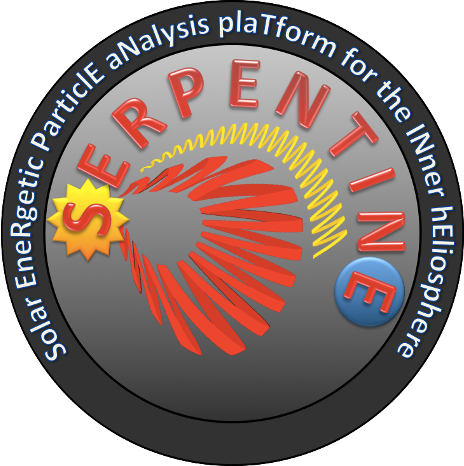STORMS
Solar Terrestrial ObseRvations and Modeling Service
SERPENTINE SYMPOSIUM
27-28 June, Toulouse


Particle Acceleration and Transport from heliospheric perspective
Scientific symposium on Particle Acceleration and Transport from heliospheric perspective: a scientific symposium on particle transport and acceleration will present the results of the SERPENTINE H2020 project in more general context of particle transport and acceleration in astrophysics from a heliospheric perspective. A number of researchers is invited also from outside the consortium, to be able to discuss the results in a more general framework. This event will serve as a means to communicate the project results to target groups T1, T2, T3 and T4, i.e., researchers and PhD students in the fields of heliophysics, space weather research and astrophysics. Zoom link for the whole symposium duration: https://univ-tlse3-fr.zoom.us/j/2531041664 Local contact: Illya Plotnikov (illya.plotnikov@irap.omp.eu)
IMPORTANT DATES
- 27-28 June: Scientific Symposium at Salle des Pèlerins, Hotel Dieu
- 29 June: SERPENTINE meeting at IRAP
- 30 June: Internal meeting at IRAP
SYMPOSIUM DINNER
- Brasserie Les Beaux Arts
- Tuesday 27 June at 20h
- Adress: 1, Quai de la Daurade, 31000 Toulouse
SYMPOSIUM PHOTO

TRANSPORTS
The Airport Shuttle Bus
Time: Leaves every half an hour between 5:40am and 00:10am.
Cost (at time of writing): 9 Euros each way
Directions: Shuttle leaves from outside main terminal. Tickets can be bought next to the tram stop (ensure you buy the shuttle ticket and not a standard one). The shuttle bus stop is to the right of the tram stop as you exit the terminal.
Destination: The shuttle stops at Compans Caffarelli and close to hotels at Jeanne d’Arc and Jean Jaures.
Mobility: The buses are adapted for access for people with reduced mobility.
https://www.tisseo.fr/en/airport-shuttle
The Tram Line T2
The Tram is under renovation since June, 5. It doesn't go to the airport this summer.
Taxi
Time: Usually available 24 hours.
Cost: Around 30-35 euros to Toulouse Center. They are readily available, but it may be cheaper to get an Uber.
Directions: Taxis line up on the road outside of the terminal, directly to the right as you leave the building.
Hotel Dieu (27-28)
- Salle de Pelerins (et Salle des Colonnes)
- Adresse: 2 rue Viguerie, TSA 8003531059 Toulouse cedex
- Dates: Tuesday-Wednesday 27-28 June
IRAP (29-30)
- Conference room
- Adresse: 9 Av. du Colonel Roche, 31400 Toulouse
- Dates: Thursday-Friday 29-30 June
- Surface 300 m2. Up to 200 persons. Equiped with screen, audio, etc.
- Cocktail in Salle de Conférences

VENUES
PARTICIPANTS
SERPENTINE CONSORTIUM
- Rami Vainio (UTU, coordinator) (Presentation)
- Nina Dresing (UTU) (Presentation)
- Jan Gieseler (UTU)
- Christian Palmroos (UTU)
- Bernd Heber (CAU)
- Yulia Kartavykh (CAU) (Presentation)
- Robert F. Wimmer-Schweingruber (CAU) TBC
- Domenico Trotta (Imperial College London) (Presentation)
- Timothy Horbury (Imperial College London) (Presentation)
- Emilia Kilpua (UH)
- Eleanna Asvestari (UH) TBC
- Diana Morosan (UH) TBC
- Raúl Gómez-Herrero (UAH)
- Javier Rodríguez-Pacheco (UAH)
- Francisco Espinosa (UAH)
- Ignacio Cernuda (UAH) TBC
- Illya Plotnikov (IRAP) (Presentation)
- Manon Jarry (IRAP) (Presentation)
- Christian Mazelle (IRAP)
PARTICIPANTS
-
Alexandre, Matthieu (IRAP)
STORMS
STORMS combines a wide range of observation and in situ measurements with heliospheric models to study and model the influence of solar activity on the near-Earth environment. Supporting operations of space missions, such as Solar Orbiter, is an important goal for this service. Poster PDF
-
Annie John, Lidiya (UTU)
The role of adiabatic focusing in coronal shock acceleration
Solar energetic particles (SEPs) are considered a serious radiation threat to space technologies and humans in orbit. The sources of SEPS are solar eruptions, i.e., solar flares and coronal mass ejections (CMEs). We have used Monte Carlo simulations to study solar particle acceleration in coronal shocks. In particular, we have studied the effect of magnetic focusing, caused by the inhomogeneity of the magnetic field, on the efficiency of coronal shock waves as particle accelerators. We employ a simple model of the coronal magnetic field and a model of the foreshock turbulence that is motivated by the assumption that instabilities driven by the accelerated particles themselves are the cause of the upstream waves that scatter the particles and enable their rapid acceleration to high energies. Magnetic focusing due to magnetic field gradient is an important physical process in the transport of SEPs, but the theoretical framework of diffusive shock acceleration (DSA) in one dimension has been developed without including focusing. We present our study of the effects of focusing on one-dimensional particle transport. Poster PDF
- Cohen, Christina (SRL Caltech)
-
Dimmock, Andrew (IRFU; invited) TBC
Backstreaming ions observed by Solar Orbiter
The Mach number of interplanetary shocks are typically between 1 and 3, which is low compared to planetary bow shocks and most astrophysical shocks. However, on 30 October 2021, Solar Orbiter measured a shock with an Alfven Mach number above 6, which can be considered high in this context. Our study examines particle observations for this shock, which provide clear evidence of ion reflection. The magnetic and electric field observations contain complex electromagnetic structures near the shock, and we investigate how they are connected to ion dynamics. The ion velocity distribution functions show clear evidence of particle reflection in the form of backstreaming ions several minutes upstream. The shock structure has complex features at the ramp as well as whistler precursors. The backstreaming ions may be modulated by the complex shock structure and the whistler waves are likely driven by gyrating ions in the foot. Suprathermal ions up to 20 keV were observed but shock-accelerated particles with energies above this were not.
Download presentation here
-
Giacalone, Joe (Univ. of Arizona)
The acceleration of heliospheric energetic particules at the termination shock in the Heliosheath
I will present recent science results on the acceleration of heliospheric energetic particles - interstellar pickup ions, termination shock particles, and anomalous cosmic rays - at the solar-wind termination shock and in the inner heliosheath region which separates the heliopause and termination shock. I will also give a brief overview of the physics of the outer heliosphere.
-
Indurain, Mikel (IRAP)
The acceleration of heliospheric energetic particules at the termination shock in the Heliosheath
As part of the Solar Terrestrial ObseRvations and Modeling Service (STORMS), an important development axis is the production of heliospheric magnetohydrodynamic (MHD) simulations for monitoring and studying.Poster PDF
-
Kieokaew, Rungployphan (IRAP)
Cross-scale energy transfer in space plsamas
The goal of our team is to review open questions involving multi-scale energy transport, dissipation, and particle energization in turbulent plasmas, with an emphasis on the synergy between state-of-art kinetic simulations and in-situ multi-spacecraft observations with current missions. As the community is now progressing towards cross-scale spacecraft constellations, e.g., HelioSwarm, we will identify appropriate multi-spacecraft analysis techniques that are critical to bring closure to these problems and enhance the scientific return of such missions. In this poster presentation, I will present the motivation and the extent of our team in the upcoming years leading up to the launch of HelioSwarm.
-
Klein, Karl-Ludwig (Obs. Paris)
Radio diagnostics of the acceleration and release of solar energetic particules
Spectral imaging at radio wavelengths probes non thermal electrons in the solar corona and the interplanetary space. It is the only direct radiative diagnostic of such electrons in the dilute plasma of the corona, where collisional processes such as hard X-ray bremsstrahlung and nuclear gamma-ray emission are inefficient. In this contribution I'll illustrate the diagnostic possibilities of radio spectral imaging with applications to the tracing of magnetic structures where energetic particles propagate, and the role of different acceleration processes in solar eruptive events.
Download presentation here
- Kouloumvakos, Athanasios (APL; invited) remote (Presentation)
-
Marcowith, Alexandre (Univ. Montpellier; invited)
Energetic particule acceleration in astrophysical shocks
Astrophysical shocks are in most of cases collisionless and are expected to be able to inject and accelerate particles up to high energies because of their high Mach numbers and the possibility they have to strongly amplify magnetic field fluctuations up to a fraction of the kinetic energy of the plasma ram pressure. Particle acceleration at astrophysical shocks now comes to a mature age thanks to recent results obtained by different simulations combining particle-in-cell and/or magnetohydrodynamics. I will describe recent observation which support particle acceleration and magnetic field amplification, then describe some relevant simulation results. I will try to address some common interests between space and astrophysical plasmas in this particular field.
- Masson, Sophie (LPP, invited)
-
Nénon, Quentin (IRAP)
Suprathermal heavy ions of the solar wind observed by Wind-STICS
Three solar wind ion families with different kinetic energy are found in the heliosphere: ^M
- thermal ions (Ek ~1-2 keV/nucleon);^M
- suprathermal ions (1 keV/nuc < Ek < 100 keV/nucleon);^M
- energetic ions (Ek > 100 keV/nucleon).^M
One of the biggest questions related to suprathermal ions is whether they are found only during solar wind events or if they are ubiquitous and always present as the suprathermal tail of the solar wind.^M We will present heavy ion observations accumulated by the unique Wind-SMS-STICS experiment which employs triple coincidence (E/q, TOF, and SSD) to scrutinize 6 keV/q to 220 keV/q ions.^M We will present case studies and the long-term averaged (2004-2021) flux and anisotropy of suprathermal H+, He++, He+, O6+, O+, C5+, and Fe10+ ions.^M The results of our study are central for not only understanding the origin of suprathermal ions, but also to estimate the effect of these ions on airless body surfaces directly exposed to the solar wind, such as the Moon. -
Nyberg, Seve (UTU)
- Oleynik, Philipp (UTU)
-
Palmroos, Christian (UTU)
- Perri, Silvia (Universitá della Calabria; invited) remote
- Pinto, Rui (CEA; invited)
-
Richardson, Ian (University of Maryland; invited)
Solar energetic particule transport in the corona and heliopshere
Observational evidence for various mechanisms of particle transport in the heliosphere and corona will be discussed with a particular emphasis on multi-spacecraft observations of widespread SEP events.
Download presentation here
- Reid, Hamish (UCL; invited)
- Rodriguez-Garcia, Laura (UAH; invited) (Presentation)
- Rouillard, Alexis (IRAP)
- Schmeider, Brigitte (Obs. Paris)
- Sieyra, Valeria (CEA) remote
- Strugarek, Antoine (CEA) remote
- Tibaldo, Luigi (IRAP; invited) (Presentation)
- Vuorinen, Laura (UTU)
- Wijsen, Nicolas (Goddard SFC; invited) remote
-
Zhuang, Bin (Univ. of New Hampshire)
Widespead 1-2MeV energetic particule associated with slow and narrow coronal mass ejections: Parker SOlar Probe and STEREO measurements
Suprathermal ions in the corona are thought to serve as seed particles for large gradual solar energetic particle (SEP) events associated with fast and wide coronal mass ejections (CMEs). A better understanding of the role of suprathermal particles as seed populations for SEP events can be made by using observations close to the Sun. We study a series of SEP events observed by the Integrated Science Investigation of the Sun (ISOIS) suite on board the Parker Solar Probe (PSP) from 2020 May 27 to June 2, during which PSP was at heliocentric distances between ~0.4 and ~0.2 au. These events were also observed by the Ahead Solar TErrestrial RElations Observatory (STEREO-A) near 1 au, but the particle intensity magnitude was much lower than that at PSP. We find that the SEPs should have spread in space as their source regions were distant from the nominal magnetic footpoints of both spacecraft and the parent CMEs were slow and narrow. We study the decay phase of the SEP events in the ~1-2 MeV proton energy range at PSP and STEREO-A, and discuss their properties in terms of both continuous injections by successive solar eruptions and the distances where the measurements were made. This study indicates that seed particles can be continuously generated by eruptions associated with slow and narrow CMEs, spread over a large part of the inner heliosphere, and remain there for tens of hours, even if minimal particle intensity enhancements were measured near 1 au.

